Art galleries exist to serve the public for a variety of reasons. Public galleries such as the National Gallery of Art in Washington, D.C., a government-funded institution, boast extensive collections and educational opportunities. Local galleries and artist collectives, like the Buckham Gallery in Flint, Michigan, provide exhibition space, exposure and collaborators for emerging and under-recognized visual artists at the community and state level, as well as for their member artists. Other galleries are private or retail-only. In all these examples, the goal is the same: to serve as centers of visual art, education and culture for the greater community.
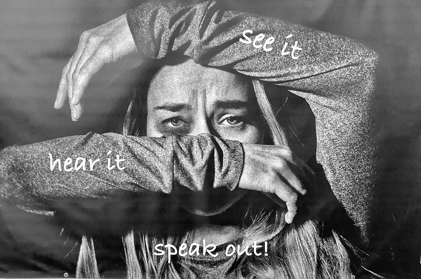
Cause & Affect Gallery
Cause & Affect Gallery in Fenton, Michigan, is just that. Driven by the motto Art with a Purpose, it seeks to raise awareness and advocacy for equality, social justice and human rights issues while providing a haven for the community. The gallery showcases and sells art from local and international artists and offers a diverse range of classes taught by members who are masters of their craft. A commitment to inclusion and making art education accessible to everyone regardless of race, ethnicity, age, ability, gender or sexual orientation is why the gallery exists. Owner and director Annie Anglim, a metalsmith specializing in silversmithing and jewelry design, founded Cause & Affect Gallery in 2019.
A native of Gladstone in Michigan’s Upper Peninsula, Anglim spent 30 years as head security supervisor for the Ann Arbor Public Schools before retiring in 2010 to devote more time to her art. An art major in college, Anglim launched her own fine art and design company, Anglim Art Design, in 2012 and has been a full-time artist for the past decade. Opening her own gallery fulfilled a lifelong dream for Anglim. Cause & Affect Gallery represents a group of over sixty artists, primarily from the state of Michigan.
Diversity, equity, inclusion, and community engagement, are all deeply important to Anglim. In an interview with Arts Help, Anglim explained that the concept for the gallery stemmed from a need to find a studio space to accommodate a wheelchair-bound friend with multiple sclerosis who wanted to take a class in silversmithing. Cause & Affect Gallery is therefore accessible to everyone regardless of age or ability. The studio space can accommodate up to 20 people with adaptable workstations for those in wheelchairs and erated equipment depending on the person’s needs.
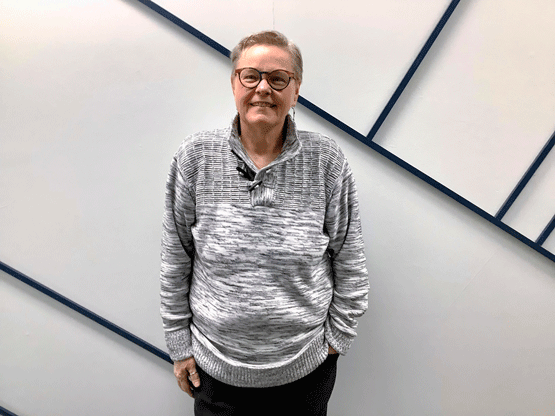
For Anglim, art is more than simply artistic expression. It is an activist platform about inclusion, pushing boundaries, and affecting positive change in the world. Using art as a means of social commentary to highlight both local and global issues and inspire societal change is Anglim’s passion. She does not shy away from exploring political and controversial subjects. To celebrate the grand opening of Cause & Affect Gallery in 2019, Anglim collaborated with Fenton High School students on an exhibition about school shootings and gun violence in the United States as the gallery’s inaugural exhibition.
Anglim works with students from Fenton Community Schools and sponsors an internship for high school students wanting to pursue careers in art. She takes Fenton schoolchildren who demonstrate promising talent under her wing to nurture their gifts and show them that anyone can be an artist.
Anglim also partners with the Ann Arbor-based global nonprofit, Buy the Change, an organization started by Kari Hughes that empowers women artisans in third-world countries to sell their work and ensures fair trade prices for their products. The money raised funds education, sanitation, business building and healthcare initiatives in their home countries. A retail area at the front of Cause & Affect currently carries items made by women artisans in India, Cambodia, Thailand, Guatemala, Kenya, Uganda, Haiti, and South Africa. In addition, ten percent of profits from all art sales and the products sold in the retail space go to selected nonprofits and local charities committed to causes important to Anglim.
The outbreak of COVID-19 hit Anglim and the gallery hard. She lost family members and for a time was too distressed to even come to the studio and work on her own art. During lockdown, she was forced to cancel all classes and close her doors. To keep the gallery afloat, Anglim used personal funds, sold work online and organized sidewalk sales. She also helped distribute free home art kits created by members of the Fenton Arts Council for families to pick up and take home.
See It, Hear It, Speak Out!
See It, Hear It, Speak Out! a new all-woman show at Cause & Affect Gallery explores the theme of violence against women — an unfortunately apt subject given the worldwide increase in domestic violence during the pandemic. Part art exhibit, part advocacy for change, the show features women whose works explore the many forms of violence that women and girls across the globe face daily because of their sexuality, gender, race and socioeconomic status. Anglim’s goal for the exhibit is to raise awareness, create change and empower women to speak their truth.
At the back of the program accompanying the exhibition, Anglim has included QR codes for people in need of help to scan for support along with that of Zonta International (the Flint chapter is a co-sponsor of the exhibition) for those interested in learning more about the organization and its advocacy to end violence against women. The works on display evince several United Nations Sustainable Development Goals (SDGs) including No Poverty, Good Health and Well-Being, Quality Education, Gender Equality, Decent Work and Economic Growth, Reduced Inequalities, Sustainable Cities and Communities, and Peace, Justice, and Strong Institutions.
A survivor of sexual assault herself, the show is very personal for Anglim. Her own works in the exhibition: All Is Not As It Appears, End Child Marriage, How Many More?, and Free Her, reflect many of the SDGs including No Poverty, Quality Education, and Gender Equality. In the painting, All Is Not As It Appears, Anglim metaphorically represents her experience being sexually assaulted on her college campus in 1979.

End Child Marriage, a mixed-media work about the impact of child marriage on the physical and mental health of girls, features the torso of a mannequin draped with an embroidered wedding veil and crown of artificial flowers, as a no smoking-like sign adhered to its chest proclaims “no child marriage.” As Anglim’s work reminds us, child marriage is not just confined to third-world countries. The youngest girl known to become a bride in Michigan was just eight years old. Even today, marriage at as young as fourteen is allowed with judicial consent in the state.
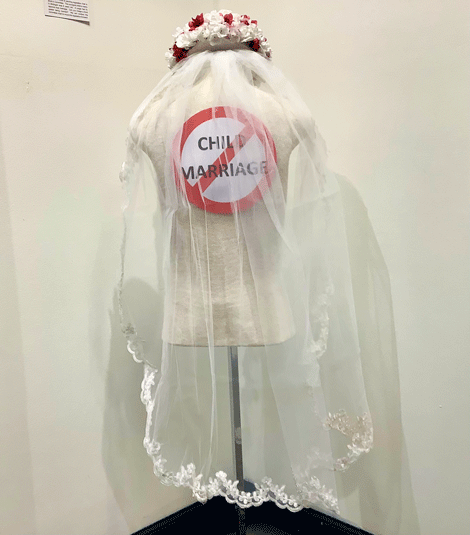
Anglim’s How Many More? an installation consisting of a pile of shoes donated by women in the Fenton community and survivors of intimate partner and domestic violence, represents the lives of women impacted by domestic violence daily in Michigan.
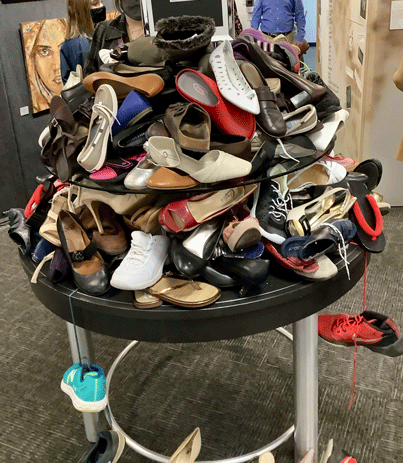
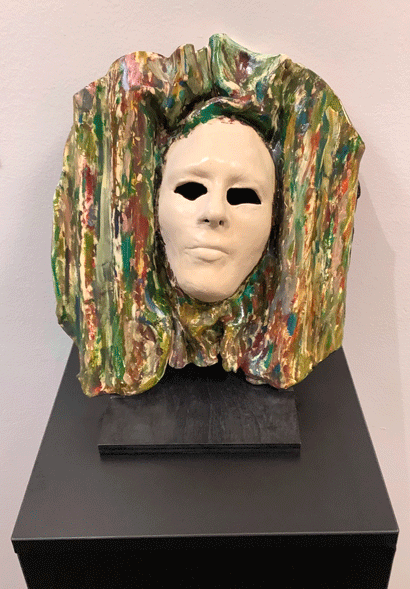
Like Anglim’s painting All Is Not As It Appears, Silence, a porcelain mask by Shauna Bradshaw is a meditation on the pain she felt in the aftermath of sexual assault by a stranger. As Bradshaw states, “The face represents innocence and the purity of our beliefs as we [women] mature into adulthood [w]hile the closed mouth reminds us of how hard it is to find our voice when that innocence is taken.”
Similar in subject to Anglim’s End Child Marriage, Priyanka Sah’s photographic diptych Existence draws attention to the plight of immigrants who come to the United States in hopes of a better life, education, and job opportunities and the challenges they experience. Thousands of South Asian women are among those who come to the U.S. annually on dependents visas. Often domestically abused, they face culture shock, depression, social isolation, psychological distress and despair. The artwork addresses what the “existence” of these women might really be.
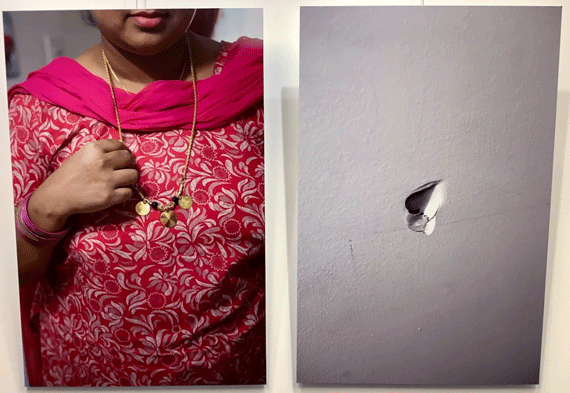
#StopAcidSales, a mixed media work by Kim Kwaz McKerracher, directly invokes gender equality through its visceral depiction of the facial deformities of a woman scarred from an acid attack. According to the plaque accompanying the work, 80% of all acid attack victims are women and girls who suffer intense pain, third or fourth degree burns, psychological trauma, economic prevation and social ostracization.
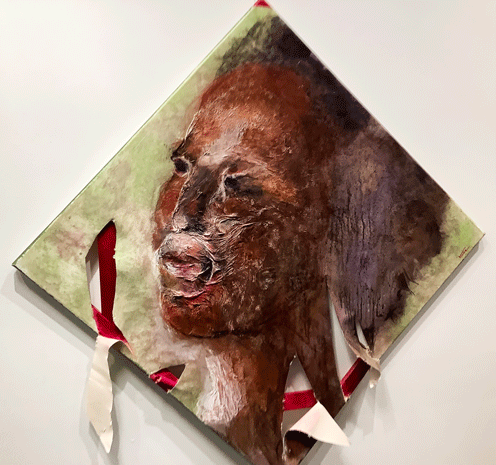
Free Her, an interactive mixed media installation Anglim built in collaboration with Chicago artist, carpenter, and metalworker Summit Ellens, simulates the experience of walking into a hut where human trafficking victims are kept. Inside, a female mannequin on a mattress cowers in fear with her hands covering her face protectively. Brightly spray-painted above and around her are many words including “free her,” “sex,” “domestic servitude,” “debt bondage” and “forced marriage.”
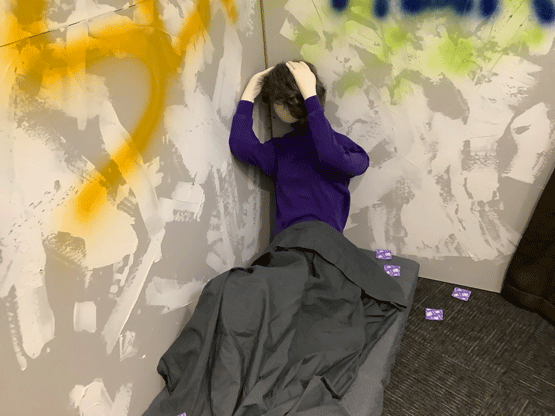
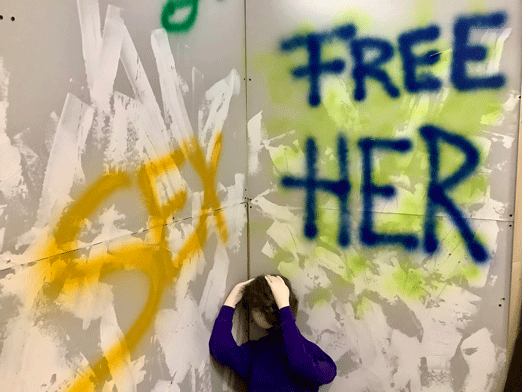
On the opposite wall, another work entitled Not For Sale is a mixed media painting by Susan Saab Hagan representing the bound hands and body of a teenage girl sold into slavery. Still another painting by Haggen, Nocturnal One, depicts a defiant-looking prostitute sitting on a curb, alludes to the fact that most sexual abuse and maltreatment of women occurs at night.
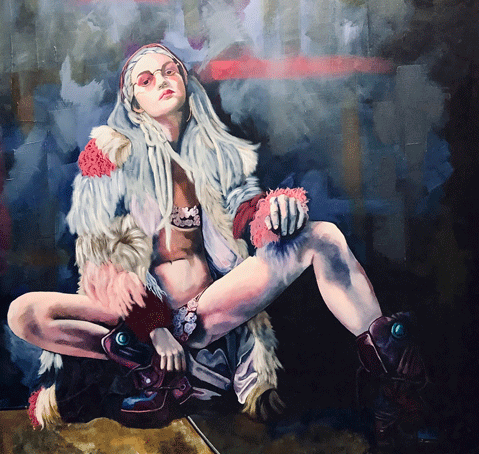
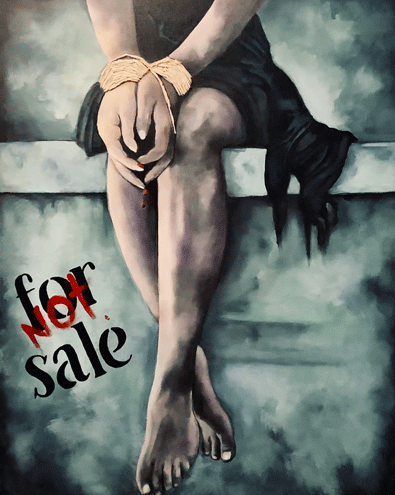
In another cultural commentary, Define Yourself, a mixed media work by Deborah Simms criticizes the continuing sexualization and objectification of women in media and advertising campaigns.
Help Me!!!!!!, a black and white photograph by Debra Perrigo-Trombly whose photograph, See it, Hear it, Speak Out! gives the exhibition its name and graces the cover of the program, dramatically represents the feelings of panic and fear victims of domestic violence experience. The ominous presence of the abuser in the shadows of Help Me!!!!! stares directly at the viewer.
But, I Love You, a vivid red painting by Julie Lindsey explores the complicated relationship between victim and abuser. The title refers to how an abuser will tell a victim “But, I love you” to manipulate them into staying. The varying shades of red and grasping hands evoke the intensity, isolation, and loneliness of domestic violence and a sense of impending doom.
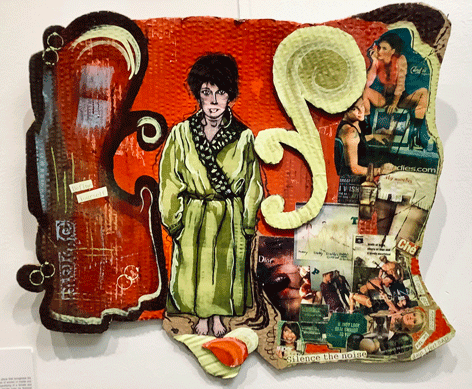
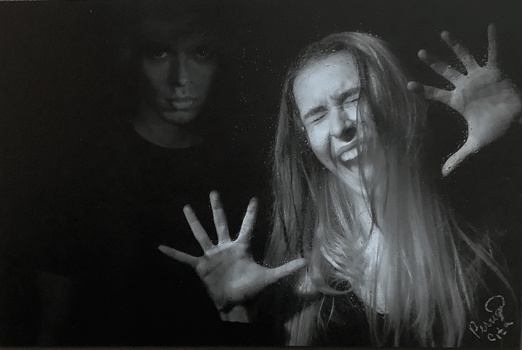
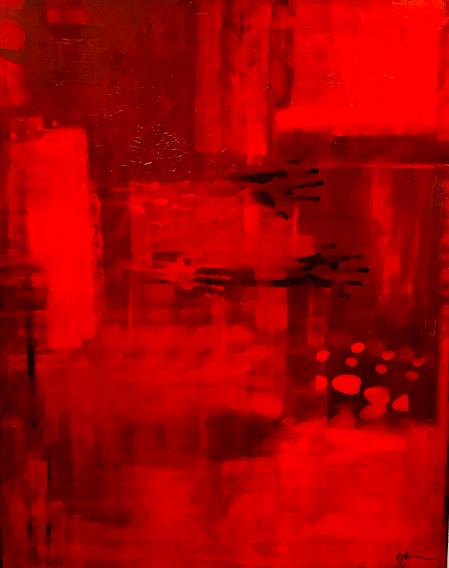
Anglim is passionate about ending violence against women and is a proud member of Zonta International, Flint Club, an international women’s rights organization dedicated to the economic, educational, legal, political and professional advancement of women. Through her affiliation with Zonta International, Anglim learned about brutal violence against women and girls, such as child marriage, forced labor, acid burnings, sexual slavery and human trafficking occurring in countries throughout the world including Cambodia, a country close to Anglim’s heart. It is from there she adopted her son and daughter and where she continues working with the Zonta Club to make life better for all Cambodians.
Domestic Violence and the Pandemic
The United Nations defines violence against women as “any act of gender-based violence that results in, or is likely to result in, physical, sexual, or mental harm or suffering to women, including threats of such acts, coercion or arbitrary deprivation of liberty, whether occurring in public or private life.” Domestic violence is a pattern of behavior in which a person uses physical, sexual and emotional abuse to control another person. Increased stress from social isolation, quarantine, and lockdowns have caused a spike in partner violence around the globe.
The pandemic has exposed the challenges and inequities women face. Lack of childcare, being forced to leave jobs to care for families, and financial difficulties have disrupted vulnerable women’s social and safety networks and access to protective services for help. The statistics are startling. Estimates by the World Health Organization’s Human Reproductive Programme (HRP) indicate that one in three women, over 30% worldwide, have experienced physical or sexual violence by an intimate partner or sexual violence by any perpetrator in their lifetime. Most of this is intimate partner violence, the most common form of violence against women.
See It, Hear It, Speak Out! runs from November 20-December 30, 2021, at Cause & Affect Gallery in Fenton. For more information, visit the gallery website here. To contribute to the exhibition’s cause, you can donate here to Zonta International.
